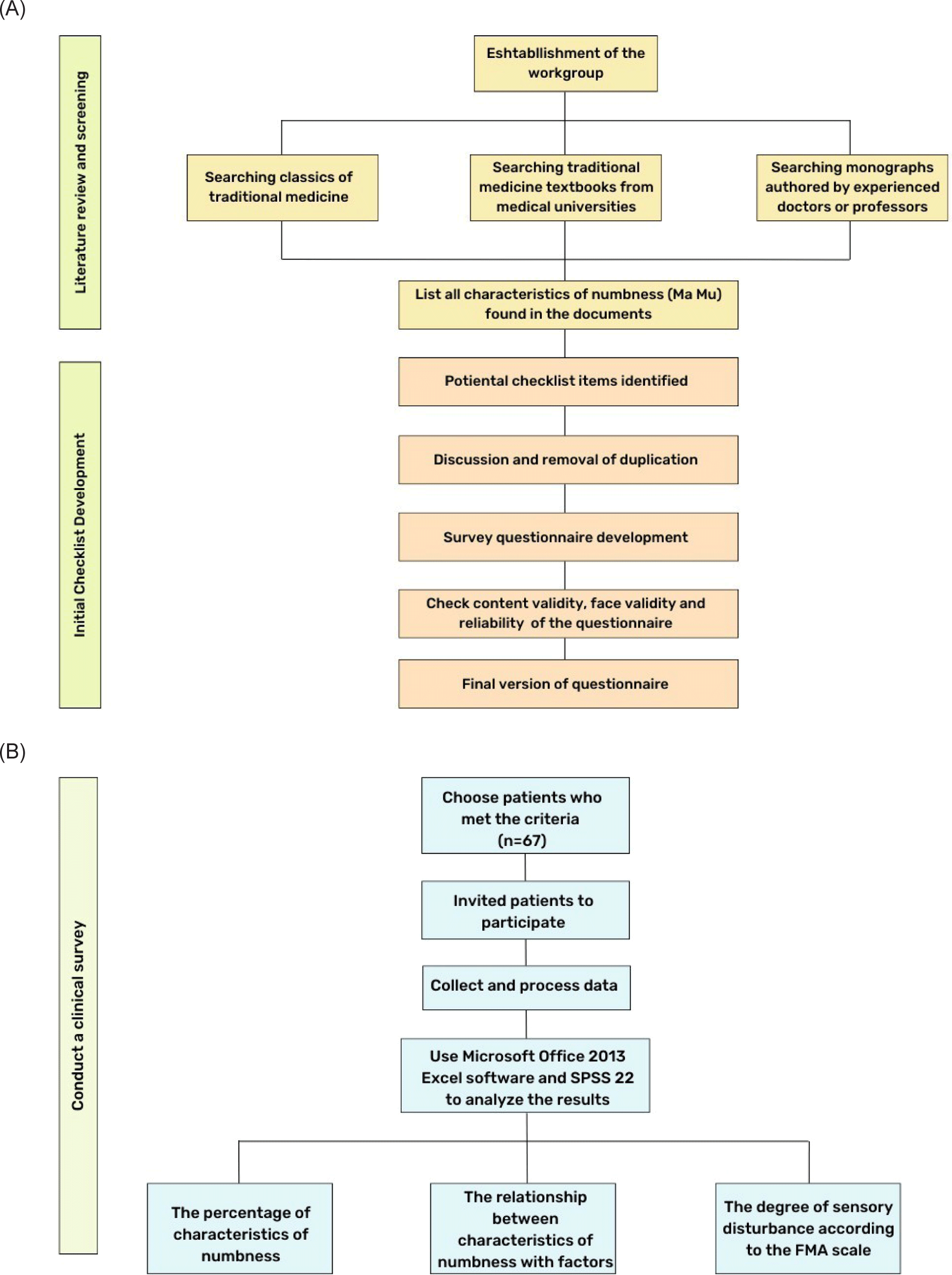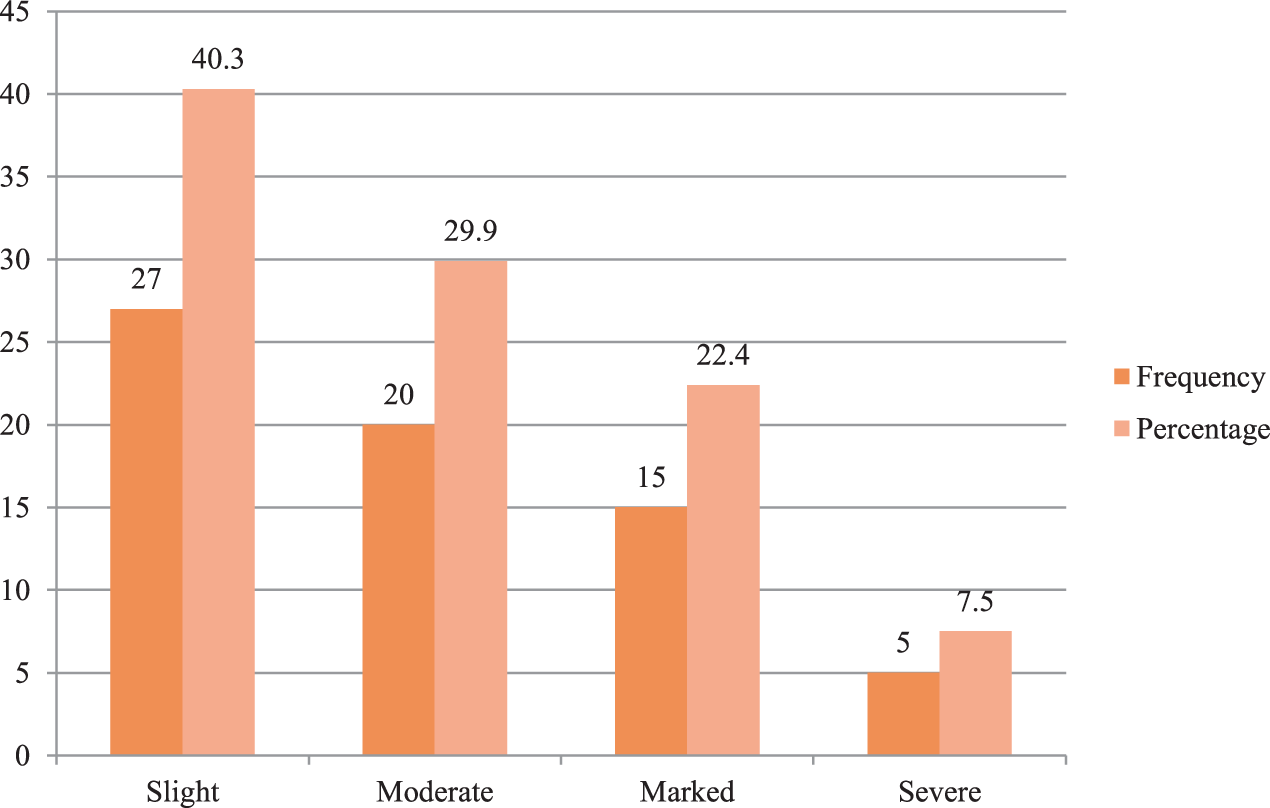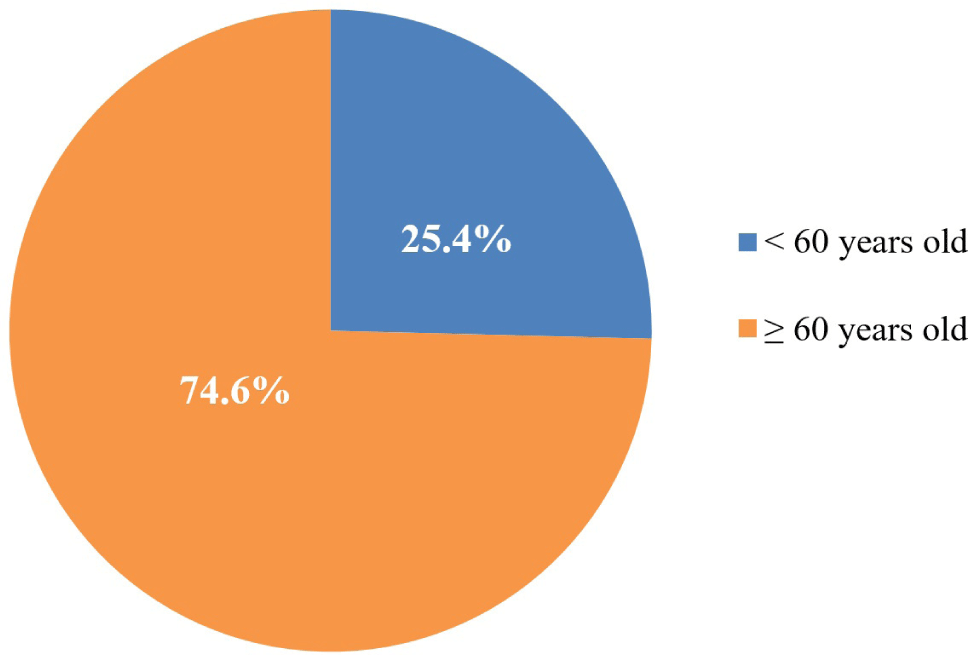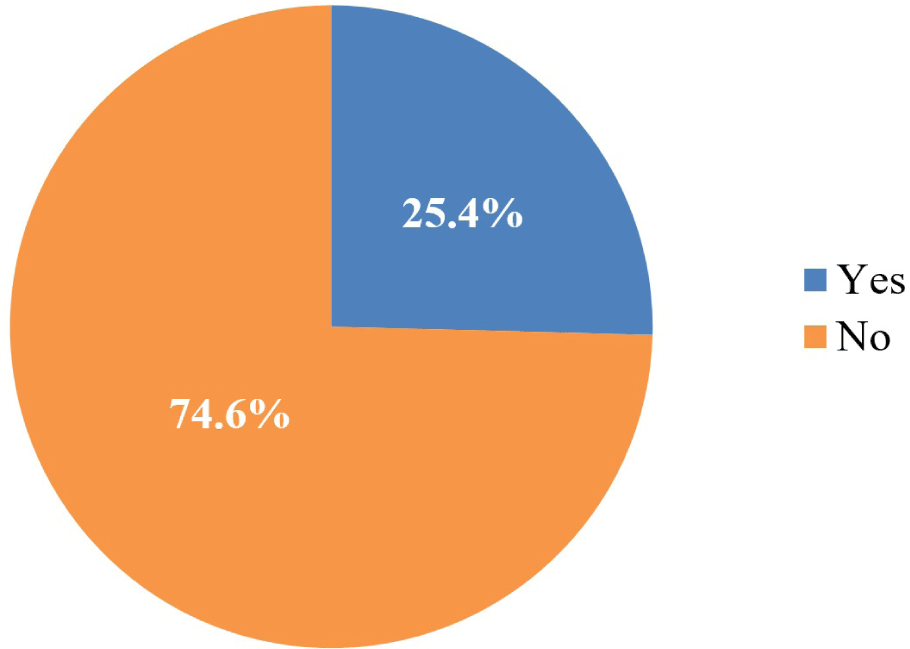1. INTRODUCTION
According to the World Health Organization (WHO), stroke was the leading cause of disability and the second leading cause of death worldwide in 2022 [1]. In Vietnam, stroke has been recognized as the primary cause of death and disability in adults, with approximately 200,000 cases reported [2]. The sensory disturbance is a common after-effect following an ischemic stroke that significantly impacts the patient’s life and causes economic and labor burdens on the family and society [3],[4]. In Vietnam, a study by Do Thi Hiep and Nguyen Thi Nguyen found that 47.6% of patients with ischemic stroke experienced sensory disturbances that were often overlooked because patients did not typically report them [4],[5]. However, the sensation was crucial for the body’s safety and could lead to complications like ulcers, abrasions, and pain. The reduced sensation could predict hospital stays, discharge, and rehab outcomes [6],[7]. Le (2021) found that patients with sensory issues had more difficulty recovering of the motor function on their left hand than those without sensory issues [8]. Thus, understanding sensory disturbances was an urgent matter that could help patients receive comprehensive early recovery treatment and reduce the risk of complications after stroke.
Traditional Chinese medicine (TCM) employed the term Ma Mu to describe sensory disturbances such as numbness and paresthesia in the skin of the extremities. In a study conducted by Li (2013) on sensory disorders related to Ma Mu in neuropathy, 4 syndromes of Ma Mu were identified in TCM [9]. In 2021, Li MengHan showed that acupotomy and Xingnao Kaiqiao in TCM could reduce ischemic stroke patients’ sensory disturbances in the rehabilitation phase [10]. While traditional medicine has been increasingly recognized for its role in the diagnosis and treatment of rehabilitation after stroke, there has been no study on the characteristics of numbness in patients with ischemic stroke, domestically and internationally. Therefore, this study aimed to investigate the characteristics of numbness (Ma Mu) in ischemic stroke patients according to traditional medicine. The results would provide a basis for individualized diagnosis and treatment that combined traditional and modern medicine, leading to early recovery after stroke and improved quality of life for patients. To achieve this objective, we first compiled a comprehensive list of numbness characteristics reported in the medical literature, and second, conducted a clinical survey and identified the characteristics of numbness in 67 patients with ischemic stroke in the early rehabilitation phase.
2. METHODS
The study consisted of two phases. Phase 1 involved using descriptive analytics to examine literature from October 2022 to December 2022. Phase 2 conducted a cross-sectional study on 67 patients with ischemic stroke in the early rehabilitation phase at the Hospital of Traditional Medicine in Ho Chi Minh City from December 2022 to June 2023.
In Phase 1, the selection criteria for research materials included textbooks on traditional medicine subjects from medical universities, classics of traditional medicine, and monographs authored by doctors or professors with more than 20 years of experience in TCM.
In Phase 2, the doctors who conducted the interviews are certified traditional medicine practitioners with at least 5 years of experience in diagnosing patients. They are trained in the method of asking questions on patients with numbness and are tested for interviewing standard process before performing interviews on patients. The assessment involved evaluating the patient’s recovery using FMA scales and recording the results on a survey sheet. The evaluator was trained in evaluating the scales through video tutorials and manuals. The selection criteria included: patients with hemiplegia due to stroke aged 18 years or older, diagnosed with ischemic stroke (according to diagnostic criteria of the Ministry of Health [11] or according to Inpatient medical records/hospital discharge papers), sensory disturbances (on the Fugl-Meyer Assessment [FMA] scale) [12], alertness, cooperation with physician [13], in the early rehabilitation phase from 24 hours to 3 months, which calculated from the time the patient had a stroke to the time of the survey (according to the the Stroke Roundtable Consortium) [14], and willing to participate in the study. Patients with cognitive disorders, speech disorders, mental disorders, dementia, or having at least one of the following four diseases: diabetes, carpal tunnel syndrome, disc herniation, or polyneuritis [15]; and patients who were unable to complete the questionnaire would be excluded from the study. The study would be halted for people who did not want to continue participating, had a serious medical condition, or were not healthy enough to continually participate. This phase proceeded in 4 steps: Step 1 was to generate a list of patients with ischemic stroke; Step 2 was to invite patients who met the selection criteria to participate, explained the study, and had them sign a research information paper if they agreed to participate. Patients could participate in the examination and answer questions on the survey form; Step 3 was to collect and process data; and Step 4 was to analyze and evaluate the results (Fig. 1).

According to a study by Nhan [16], we used p=0.044316. We used tolerable error (d) as 0.05; and reliability as 95% which means Z was equal to 1.96. Applying the formula, we calculated our sample size:
This study chose 67 patients who met the criteria.
The survey was divided into the questionnaire and sensory examination based on the FMA scale.
In Phase 1, we began by selecting standard medical literature and compiling a list of all characteristics of numbness found in these documents. After discussing and removing any duplicated items, we determined content validity, face validity and internal consistency (reliability) through the assessment of 7 experts and 30 volunteers. Either relevancy or clarity was assessed for each question according to its role based on the Likert scale [17],[18]. The content value is determined through the Content Validity Index for Items (I-CVI). The I-CVI index is the ratio between the number of experts assessed “usable” and the total number of experts. Our study had 7 medical practitioners, corresponding to the I-CVI value greater than 0.80, indicating adequate levels of clarity [19].
The face validity was determined by 30 volunteers in pilot trial. Volunteers have no difficulty in comprehending the content of the scale’s questions and can answer them easily without asking many questions during the interview process.
Internal consistency was evaluated by Cronbach’s alpha coefficient for each of the 9 sub-scales. In which, Cronbach’s alpha coefficient was accepted when the threshold was ≥0.70 [20]. In contrast, Cronbach’s alpha coefficient was too high suggesting that some questions in the scale overlapped each other or had the same idea, the maximum recommended threshold was ≤0.90 or ≤0.95 [21]. Cronbach’s alpha coefficient of the questionnaire ranged from 0.7 to 0.83, surpassing the threshold of 0.70 and indicating good internal reliability.
The questionnaire included administrative sections such as abbreviated name, age, gender, place of residence (city province), height, weight, body mass index (BMI), stroke time (from onset to survey), and the characteristics of numbness in patients with ischemic stroke recorded from the literature in Phase 1.
The FMA used the FMA Scale to evaluate the motor function, balance, sensation, and joint function in stroke patients with hemiplegia. For sensory evaluation, the FMA scale has been found to have high reliability between assessors who perform repeated assessments in many trials (intra-rater) and among many assessors who also participate in the assessment on the same scale (inter-raters) in chronically disabled patients, as well as in patients recovering less than 6 months from stroke [22]. Katherine (2011) showed that the Fugl Meyer Assessment (FMA) scale was evaluated for its ability to assess motor-sensory impairment after stroke. It was highly reliable when compared to expert judgment. Using the FMA to determine the severity of motor and sensory impairment in clinical practice or rehabilitation studies [12]. Sensory impairment was classified into four levels according to the FMA scale: slight (>19 points), moderate (14–19 points), marked (9–13 points), and severe (0–8 points) [12],[23],[24].
Data were entered using Microsoft Office 2013 Excel software and analyzed using SPSS 22 (IBM, Chicago, IL, USA). For qualitative variables, we used frequency and percentage to describe the data. We presented the mean±SD for quantitative variables or the median and interquartile range if not normally distributed.
We utilized multivariable logistic regression to investigate the relationship between two qualitative variables in univariate analysis. We considered differences to be statistically significant when p<0.05. We used multiple linear regression analysis to account for potential confounders.
We used the consensus-based checklist for reporting of survey studies (CROSS) to guide the reporting of our study [25].
3. RESULTS
There were 11 medical literature sources (Table 1) investigating 9 characteristics of numbness. S1 was the most frequently documented characteristic (63.6%). S3, S8, and S9 had a rate of 36.4%, followed by S4 and S6 with a rate of 27.3%. S2, S5, and S7 were documented the least (18.2%) (Table 2). Our study selected all 9 TCM characteristics of numbness to conduct a clinical survey (phase 2). Syndromes of numbness, Phlegm-Dampness, and Blood Deficiency were the most frequent syndromes (63.6%), followed by Qi Deficiency and Pathogenic Wind, Cold, and Dampness, with a rate of 54.5%. Blood and Qi Stagnation was the least (27.3%) (Table 3).
| Syndromes | Frequency (N=11) | Percentage |
|---|---|---|
| Qi deficiency | 6 | 54.5 |
| Blood deficiency | 7 | 63.6 |
| Pathogenic wind, cold, and dampness | 6 | 54.5 |
| Phlegm-dampness | 7 | 63.6 |
| Blood and qi stagnation | 3 | 27.3 |
A clinical study on 67 patients with ischemic stroke in the early rehabilitation phase at the Hospital of Traditional Medicine in Ho Chi Minh City showed that:
The average age of patients was 65.81±10.40 years, with the majority (74.6%) being in the ≥ 60 years old group (Fig. 2). Regarding sex, males comprised the majority (52.2%), 1.1 times higher than females. The prevalence of obesity was 25.4% (Fig. 3). The average stroke time of patients was 59.87±33.14 days (Table 4).
| Sample | Mean±SD | |
|---|---|---|
| Age | 65.81±10.40 | |
| Stroke time | 59.87±33.14 | |
| Frequency (N=67) | Percentage | |
| Gender | ||
| Female | 32 | 47.8 |
| Male | 35 | 52.2 |
In clinical research, 9 characteristics of numbness (S1 to S9) were examined. The most commonly recorded characteristic was S4 (97%), while the least was S7 (13.4%) (Table 5).
The degree of sensory disturbance according to the FMA scale in patients with ischemic stroke in the early rehabilitation phase recorded that the highest rate was Slight (40.3%), and the lowest rate was Severe (7.5%) (Fig. 4).

Multivariate logistic regression analysis showed that obesity, the degree of sensory disturbance was a significant factor in the characteristics of numbness (p<0.05). Specifically, patients with marked sensory disturbances were 8.2 times more likely to have S2 characteristic than those with slight sensory disturbances. Patients with obesity were 11.54 times more likely to have S5 characteristic than those without obesity. Patients with moderate and marked sensory disturbances were 9.61 times and 14.86 times more likely to have S6 characteristic, respectively, than those with slight sensory disturbances (Table 6).
According to a multiple linear regression, confounding factors such as age, gender, BMI, and stroke time did not affect the characteristics of numbness in patients with ischemic stroke (p>0.05) (Tables 7–15).
| Characteristics | B | p-value |
|---|---|---|
| Feeling of heaviness in the affected area | 1.155 | 0.052 |
| Age | 0.001 | 0.863 |
| Gender | –0.182 | 0.105 |
| Stroke time | 0.000 | 0.901 |
| BMI | 0.013 | 0.511 |
| Characteristics | B | p-value |
|---|---|---|
| Feeling of tension in the affected area | 1.817 | 0.006 |
| Age | –0.003 | 0.621 |
| Gender | –0.069 | 0.570 |
| Stroke time | –0.002 | 0.190 |
| BMI | 0.012 | 0.554 |
| Characteristics | B | p-value |
|---|---|---|
| Sensation of crawling insects | 1.102 | 0.110 |
| Age | 0.002 | 0.735 |
| Gender | 0.026 | 0.839 |
| Stroke time | –0.001 | 0.457 |
| BMI | 0.015 | 0.507 |
| Characteristics | B | p-value |
|---|---|---|
| Numbness in a fixed position | 1.063 | 0.000 |
| Age | –0.001 | 0.730 |
| Gender | 0.064 | 0.145 |
| Stroke time | 0.000 | 0.814 |
| BMI | –0.004 | 0.606 |
| Characteristics | B | p-value |
|---|---|---|
| Increased numbness with movement | 2.397 | 0.000 |
| Age | 0.005 | 0.325 |
| Gender | –0.016 | 0.882 |
| Stroke time | –0.002 | 0.311 |
| BMI | –0.035 | 0.055 |
| Characteristics | B | p-value |
|---|---|---|
| Increased numbness when exposed to cold | 2.171 | 0.001 |
| Age | 0.002 | 0.714 |
| Gender | –0.085 | 0.477 |
| Stroke time | –0.004 | 0.058 |
| BMI | –0.013 | 0.535 |
| Characteristics | B | p-value |
|---|---|---|
| Increased numbness when exposed to moisture | 2.114 | 0.000 |
| Age | –0.001 | 0.866 |
| Gender | –0.059 | 0.508 |
| Stroke time | –0.001 | 0.444 |
| BMI | –0.002 | 0.885 |
| Characteristics | B | p-value |
|---|---|---|
| Decreased numbness with warm compresses | 2.542 | 0.000 |
| Age | –0.007 | 0.278 |
| Gender | –0.003 | 0.982 |
| Stroke time | 0.001 | 0.739 |
| BMI | –0.025 | 0.264 |
| Characteristics | B | p-value |
|---|---|---|
| Decreased numbness when pressed | 1.302 | 0.058 |
| Age | 0.004 | 0.530 |
| Gender | 0.047 | 0.718 |
| Stroke time | 0.002 | 0.282 |
| BMI | –0.012 | 0.581 |
4. DISCUSSION
TCM employed the term Ma Mu to describe sensory disturbances such as numbness and paresthesia in the skin of the extremities, which involved “Ma” meant tingling, while “Mu” meant numbness [26]. To diagnose and treat numbness (Ma Mu) using TCM, it was necessary to understand the symptoms of the disease and apply theories of TCM to classify them into suitable syndromes [27]. There were 9 characteristics recorded in the medical literature that were consistent with the theory of TCM about numbness. Based on the pathogenesis of numbness, there were two causes of the disease: exogenous pathogenic factors (climatic factors) and endogenous pathogenic factors (improper diet, long-term illness). Climatic factors invaded the pulse, healthy qi fought against evil qi, hindered the flow of qi and blood, reduced the defensive qi in the body and the skin, the specifically pathogenic wind caused S3 symptom (sensation of crawling insects), the pathogenic cold caused S6 symptoms (increased numbness when exposed to cold) and S8 symptoms (decreased numbness with warm compresses), and pathogenic dampness caused S7 symptoms (increased numbness when exposed to moisture). Overeating fatty and sweet food could exceed the spleen’s metabolic capacity, impair the spleen’s ability to transport and transform water, and create phlegm. This phlegm could block the meridians and cause various symptoms, including S1 (feeling of heaviness in the numbness area), S2 (feeling of tension in the numbness area), S4 (numbness in a fixed position), and S9 (decreased numbness when pressed). Long-term illness normally causes yin deficiency which produces internal heat that burns blood, in turn it causes blood stagnation for functioning, or blood deficiency fails to nutrient the meridians, dermal capillaries, and muscles. Specifically, blood deficiency causes S3 (sensation of crawling insects), qi deficiency caused S5 (increased numbness with movement), and S6 (increased numbness when exposed to cold) [28],[29]. This study selected all the symptom characteristics collected from the literature and included them as the standard for surveying in the clinical investigation phase. The advantage of selecting all characteristics is that to not leave out on symptoms that were clinically present or were rarely present, but when present were a particular characteristic of a syndrome [30].
The study found that slight had the highest rate (40.3%) according to the FMA scale, while severe had the lowest rate (7.5%). Dividing sensory disturbances according to the FMA scale, based on research by Fugl-Meyer [12],[23],[24], could help determine the disease’s severity, plan treatment, and assess the patient’s recovery in clinical practice.
After conducting the clinical survey, our study recorded nine 9 characteristics of numbness according to TCM. The most dominant characteristic was S4 (numbness in a fixed position) (97%), and the second was S1 (feeling of heaviness in the numbness rea) (74.6%). The least was S7 (increased numbness when exposed to moisture) (13.4%). Compared with the prevalence in the literature, characteristic S1 (feeling of heaviness in the numbness area) was recorded in most literature (63.6%), while the clinical reality was S4 (numbness in the fixed position) had the highest rate (97.0%). Both of these characteristics belong to the phlegm-dampness syndrome. Phlegm was formed due to the accumulation of body fluids, which had little fluidity and was challenging to dissipate [31]. This result could explain why the most common characteristic in patients was numbness in a fixed position. Characteristic S7 (increased numbness when exposed to moisture) was recorded at least in both the literature (18.2%) and clinical (13.4%). This characteristic is caused by pathogenic dampness in patients with wind-stroke. Although dampness was one of the most common causes, most cases were due to internal phlegm caused by impaired spleen and stomach or wood liver restraining earth spleen, with very few cases recorded due to pathogenic dampness. In the pathogenesis of wind-stroke, internal wind was the main cause of the disease, while exogenous pathogenic factors only served as promoting factors. For example, if phlegm was present in the body and encountered climate factors that caused it to ascend, this could lead to brain deadlock and cause wind-stroke [32],[33].
There was a relationship between S5 characteristics (increased numbness with movement) and obesity. According to TCM, S5 was a manifestation of qi deficiency. The recovery period of the disease was dominated by deficiency, which mainly included qi deficiency syndrome. Therefore, it was one of the most common clinical stroke syndromes [34]. According to traditional medicine, the movement of qi was manifested through living activities inside and outside the body, in which external activities were expressed through hearing, speaking, seeing, and feeling… When qi deficiency occurred, it caused symptoms of impaired basic qi function and decreased sensation [28]. Therefore, if a person with numbness experiences the qi deficiency syndrome while exercising, their qi deficiency would worsen, leading to increased numbness symptoms. Nathan’s study found that the risk of decreased sensory neurotransmission in obese subjects was 3.5 and 4.1 times higher on two measurements than leaner individuals [35]. The mechanism linking obesity and decreased sensory neurotransmission was not yet clear. However, Werner hypothesized that it could be related to changes in metabolism. Specifically, Werner suggested that the association between obesity and impaired glucose metabolism was the most likely cause of the decreased sensory neurotransmission observed in obese individuals [36].
There was a relationship between S6 characteristics (increased numbness when exposed to cold) and the degree of sensory disturbance according to FMA. According to TCM, when there was a deficiency in qi, the protecting function of qi became weakened, leading to a decline in body resistance. This allowed pathogenic cold to penetrate, making the skin and muscles to become cold and malnourished, causing increased numbness when exposed to cold (cold weather or when dipping hands and feet in cold water) [25]. In a study by Nubia Maria Lima, cryotherapy - placing the paralyzed side in water at 15℃ for 20 minutes - decreased the average sensory FMA score. Before the therapy, the average score was 6 points, and 5 weeks after the treatment, the average score reduced to 4 points. Research has also shown that exposure to low temperatures, specifically cold water, could slow down the rate of sensory neurotransmission [37]. Sensory after-effects such as cold sensation and numbness had been reported following distal axonal stroke. This phenomenon was caused by chronic ischemia of diseased extremities due to dysregulation of the central nervous system’s vasomotor regulatory system. Cold weather was considered a trigger, and dysesthesia symptoms might improve with warmer weather or after a hot bath [38].
There was also a relationship between S2 characteristics (feeling of tension in the numbness area) with the degree of sensory disturbance according to FMA. The book “Zhang Shi Yi Tong” wrote: “Ma can be caused by phlegm or damage, while Mu refers to phlegm–dampness and blood stasis, indicating an area that does not know pain or itching, feeling like being paresthesia”. According to TCM, when phlegm flows in the meridians, it can block the meridians and hinder qi’s flow. When qi does not move and stagnate, it could cause feelings of tension and swelling [39]. Therefore, the mechanism causing the feeling of tension in the numb area was qi stagnation. Many studies have found that qi stagnation was related to various features such as hemodynamics, hematology, neuroendocrine function, vascular endothelial cells, blood lipids, inflammatory factors, genes, proteins, and metabolism. This was manifested by a decrease in peripheral vascular elasticity [40]. It was possible to hypothesize that the mechanisms mentioned above led to ischemia in the extremities and damaged sensory nerves, which affected the degree of sensory disturbance experienced by patients.
Our study was the first to investigate the characteristics of numbness in patients with ischemic stroke during the early rehabilitation phase. The research results partly met our goal of surveying the rate of occurrence of clinical characteristics of numbness, providing us with a more realistic view of the occurrence rate of these characteristics in reality versus the literature. The research also determined that there was a correlation between the characteristics of numbness with other factors such as BMI and the degree of sensory disturbance according to FMA, creating a premise for further research to find out the correlation between the control characteristics of TCM with other factors of modern medicine. However, our study had some limitations. It was conducted on a limited number of samples from only one hospital in Ho Chi Minh City over 6 months (from December 2022 to June 2023); therefore, it did not represent the overall population. Additionally, the study was only performed on stroke patients in the early rehabilitation phase; therefore, it did not represent the entire stroke population. Future studies could expand on the number of sample size, sampling locations, and focus the investigations in stroke phases such as the acute, late rehabilitation, and chronic phases.
5. CONCLUSION
This study explored the characteristics of numbness in patients with ischemic stroke during early rehabilitation. The study identified 9 characteristics of numbness, revealed the occurrence rate of numbness characteristics in clinical practice and established a relationship between numbness characteristics and obesity and the degree of sensory disturbance according to the FMA scale. These results can help diagnose traditional medicine syndrome of numbness, develop appropriate treatment methods, and improve patients’ quality of life. Moreover, they provide a foundation for future research to explore the correlation between traditional medicine characteristics and other modern medicine factors.









